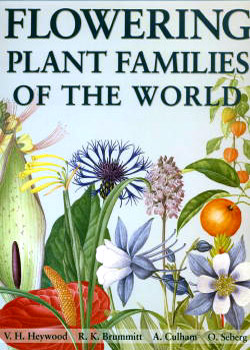For anyone interested in the relationships of Australian plant families and the species they contain with those in the rest of the world, this book is a must. This book is a sequel to Flowering Plants of the World published in 1978, which contained 306 families while this edition contains 506 families. Obviously the definition and erection of a plant family is a human construct but new technologies involving large data sets and DNA analysis have contributed to an increase in the number of what are largely minor plant families. The authors recognise that this is a work in progress representing the 'current state of play' which will no doubt change in the future. They also acknowledge the significance of the data available in Australia's Virtual Herbarium and the shift towards electronic taxonomic databases. The book is divided into a small section on classification, a detailed and well illustrated glossary and an A-Z of plant families divided traditionally between the Dicots and Monocots. Species in selected families are beautifully illustrated with black and white and colour taxonomic drawings. I could only find four Australian species represented, namely Anigozanthus viridus, Callistemon subulatus, Cephalotus follicularis (Albany pitcher plant) and Grevillea robusta. It is disappointing that some large families such as Goodeniaceae are not illustrated whereas some monogeneric families, such as Callitrichaceae (water starwort) are. The classification is a modification of the Angiosperm Phylogeny Group II classification (2003) based on DNA sequencing and is a useful table for the reader to see the relationships of the different plant families at a glance. For example I was very surprised to learn that the closest families to the Proteaceae are the Nelumbonaceae (sacred lotus) and Platanaceae (plane trees). Under each family there are paragraphs on distribution - with a world or more local map; a detailed taxonomic description; classification - including representative species and subfamilies; and economic uses. Selected families are illustrated. Flowering plants evolved in central Gondwana some 125 million years ago and radiated across this land mass to the different continents, as we now know them. As Gondwana split up the floras became relatively isolated and evolved further. What is not often realised is that Australia received some of the earliest ancestral flowering plants such as Austrobaileya, a climber from the northern rainforests in its own monogeneric family, as well as many representatives from the ancestral Magnoliids, from which the Eudicots (the more advanced Dicots) and Monocots evolved. The Magnoliids include plants like Tasmannia (Mountain Pepper) in the Winteraceae, Atherosperma (Sassafras) in the Atherospermataceae (which also has two species in Chile), and those in the closely related Monimiaceae including our local Hedycarya (native mulberry). One of the most primitive rainforest trees is Idiospermum found in the Daintree. It belongs to Calycanthaceae which also contains Chimonanthus (wintersweet) from China often grown in Canberra gardens. Our northern rainforests are dominated by the laurels in the Lauraceae, which in southern parts also contains the parasitic dodder (Cassytha) - a surprising alliance but confirmed by DNA analysis. When we move to the eudicots I have just made a small selection of items of interest. For example in the Cunoniaceae we have Eucryphia (pinkwood), species of which are also found in South America. Specimens of these can be seen the Devonport Botanic Gardens. The Dilleniaceae contains our own Hibbertia, which extends as far as Madagascar. There is an error in this family section, namely Tetratheca for Tetracera. Our Tetratheca used to belong in the Tremandaceae but has been moved to the Eleaocarpaceae (Quandongs etc) according to current data.This is another family with Gondwana connections. There are some plant families with Australian representatives that I had never heard of before, such as Phyllanthaceae, containing Phyllanthus (thyme spurge, present on Black Mountain) and Breynia, and Picrodendraceae, containing Micranthium. These two families have been segregated from the Euphorbiaceae, which is where they are listed in the Flora of NSW. Phyllanthus is interesting in that it is one of the largest plant genera with 1200 species, obviously most of them not Australian. Another family of interest is Loganiaceae for which we have the type genus Logania, seen at Booroomba Rocks. This family is pan-tropical and also contains plants in the genus Strychnos that contain the poisonous alkaloid strychnine. Most Rhamnaceae occur in North America and Eurasia but are well represented in Australia by genera such as Pomaderris, however, the map largely ignores the wide distribution of this family throughout Australia. As far as the Monocots are concerned Australia is relatively rich in endemic families. Among the new families noted is Johnsoniaceae, which is erected for Caesia, also found in South Africa and Madagascar and formerly in the Anthericaceae. One controversial classification is that of Laxmanniaceae for Lomandraceae, combining Lomandra with the lilies from Anthericaceae such as Arthropodium. My favourite family has to be Degeneraceae which contains only one species, a tree confined to two islands of Fiji. Readers should also know that I am a biased reviewer of this highly recommended book because it emanates from the University of Reading Botany Department where I undertook my undergraduate studies.
From the newsletter of the Australian Native Plants Society (Canberra), June 2009.
Australian Plants online - 2009 |

